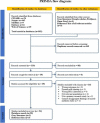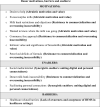Factors associated with informal human milk sharing among donors and recipients: A mixed-methods systematic review
- PMID: 38457478
- PMCID: PMC10923476
- DOI: 10.1371/journal.pone.0299367
Factors associated with informal human milk sharing among donors and recipients: A mixed-methods systematic review
Abstract
Background: The multiple benefits associated with the provision of human milk exceed individual health outcomes, engendering substantial economic, societal and environmental domains. Human milk is the absolute, unparalleled source of nutrition for infants. Informal human milk sharing is a modernistic and rapidly progressing practice. No systematic review of the factors associated with this contemporary practice among donors and recipients of informal human milk sharing exists.
Aim: The aim of this review was to identify, evaluate, synthesize and integrate the evidence on the factors associated with informal human milk sharing among donors and recipients.
Methods: A mixed methods systematic review was conducted according to the Joanna Briggs Institute methodological guidance utilizing a convergent integrated approach. The following databases were systematically searched: CINAHL, Scopus, Medline and Embase and Web of Science between inception to August 2023. A grey literature search was conducted using multiple techniques. This review followed the Preferred Reporting Items for Systematic Reviews and Meta-Analyses guidelines.
Results: Twenty-four studies were included in this review. Ten integrated findings relating to the factors associated with informal human milk sharing among donors and recipients were identified. The four integrated findings pertaining to donors included: altruistic motivation and value, resistance to commercialization and overcoming inaccessibility, uniting digital and personal connectedness and lack of awareness and acceptance of informal human milk sharing in healthcare settings. The six integrated findings relating to recipients included: maternal or infant factors, superiority and advantageous impact of breastmilk, human milk bank influences, digital connections and transparency, healthcare professional facilitation of informal human milk sharing, and professional and logistical implications.
Conclusion: This review highlighted a multitude of factors that motivate, facilitate and impede the practice of informal human milk sharing. Future research is required to explore these factors further within broader geographical locations to enhance the generalizability and rigor of the body of knowledge. Further studies should consider the exploration of the experiences and psychological impact of informal human milk sharing on donors and recipients. The provision of human milk to all infants is an imperative public health endeavor and thus positioning this as a key benchmark for research and practice is crucial.
Copyright: © 2024 Vickers et al. This is an open access article distributed under the terms of the Creative Commons Attribution License, which permits unrestricted use, distribution, and reproduction in any medium, provided the original author and source are credited.
Conflict of interest statement
The authors have declared that no competing interests exist
Figures
Similar articles
-
Peer-to-Peer Human Milk Sharing Through Social Media Groups: The Experiences of Women Donors and Recipients in Hong Kong.J Adv Nurs. 2025 Jun;81(6):3166-3179. doi: 10.1111/jan.16518. Epub 2024 Oct 7. J Adv Nurs. 2025. PMID: 39373552 Free PMC article.
-
Unveiling the voices: Exploring perspectives and experiences of women, donors, recipient mothers and healthcare professionals in human milk donation: A systematic review of qualitative studies.Women Birth. 2024 Sep;37(5):101644. doi: 10.1016/j.wombi.2024.101644. Epub 2024 Jul 9. Women Birth. 2024. PMID: 38986194
-
A scoping review on current technology-based approaches to support breastfeeding and informal human milk exchange practices.PLoS One. 2023 Sep 14;18(9):e0290311. doi: 10.1371/journal.pone.0290311. eCollection 2023. PLoS One. 2023. PMID: 37708192 Free PMC article.
-
A critical review of human milk sharing using an intersectional feminist framework: Implications for practice.Midwifery. 2018 Nov;66:141-147. doi: 10.1016/j.midw.2018.08.014. Epub 2018 Aug 22. Midwifery. 2018. PMID: 30172991 Review.
-
Human Milk Sharing in the United States: A Scoping Review.Breastfeed Med. 2022 Sep;17(9):723-735. doi: 10.1089/bfm.2022.0013. Epub 2022 Aug 10. Breastfeed Med. 2022. PMID: 35950977
Cited by
-
Peer-to-Peer Human Milk Sharing Through Social Media Groups: The Experiences of Women Donors and Recipients in Hong Kong.J Adv Nurs. 2025 Jun;81(6):3166-3179. doi: 10.1111/jan.16518. Epub 2024 Oct 7. J Adv Nurs. 2025. PMID: 39373552 Free PMC article.
-
Donor human milk practice in Indonesia: a media content analysis.Front Nutr. 2024 Sep 18;11:1442864. doi: 10.3389/fnut.2024.1442864. eCollection 2024. Front Nutr. 2024. PMID: 39360271 Free PMC article.
-
Understanding modifiable barriers to human milk donation in the United Kingdom.J Hum Nutr Diet. 2025 Feb;38(1):e13405. doi: 10.1111/jhn.13405. J Hum Nutr Diet. 2025. PMID: 39618066 Free PMC article.
References
-
- World Health Organization. Infant and young child feeding: key facts. 2021. [cited 18 August 2023] Available from: https://www.who.int/news-room/fact sheets/detail/infant-and-young-child-feeding.
-
- American Academy of Pediatrics. Policy statement: breastfeeding and the use of human milk. 2022. [cited 18 August 2023] Available from: 10.1542/peds.2022-057988. - DOI
-
- Holden E, Linnerud K, Banister D. The imperatives of sustainable development: The imperatives of sustainable development. Sustain. Dev. 2017; 25(3), 213–226. doi: doi.org/10.1002/sd.1647
Publication types
MeSH terms
LinkOut - more resources
Full Text Sources




